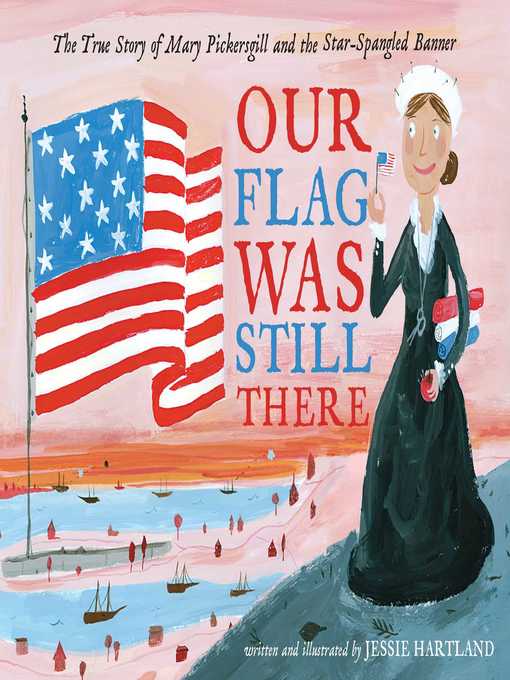
Our Flag Was Still There
The True Story of Mary Pickersgill and the Star-Spangled Banner
فرمت کتاب
ebook
تاریخ انتشار
2019
Lexile Score
790
Reading Level
2-3
ATOS
4.2
Interest Level
K-3(LG)
نویسنده
Jessie Hartlandشابک
9781534402348
کتاب های مرتبط
- اطلاعات
- نقد و بررسی
- دیدگاه کاربران
نقد و بررسی

March 15, 2019
The story of the flag that inspired the national anthem, from its commissioning through its construction by Mary Pickersgill to its current place at the Smithsonian.Though the subtitle and cover feature Mary Pickersgill, Hartland's book is really about the flag itself. The story covers how America came to be at war, how Pickersgill's shop came to sew the flag, how Francis Scott Key wrote "The Star-Spangled Banner," and how the flag was preserved and is currently displayed. Hartland's gouache, folk-art-style illustrations provide a nice amount of detail, with much for readers to linger over and admire, though the playful pennant advertising crabcakes is likely anachronistic. Working to make the book accessible to readers, Hartland takes great care to explain why flags were so important in a time before telephones, but she fails to provide context as to why sewing a large flag would take such an effort. Though she is unnamed, close readers of history will appreciate the inclusion of the white woman's oft-excluded indentured black servant, Grace Wisher. (Pickersgill's history as a slave owner goes unmentioned, however). Perhaps the most fascinating part of the book is what actually happened to the flag after the war, and a lovely two-page spread outlines the process in a series of paneled illustrations.A surface-level introduction. (author's note, source notes, bibliography, further reading, timeline.) (Informational picture book. 6-8)
COPYRIGHT(2019) Kirkus Reviews, ALL RIGHTS RESERVED.

April 22, 2019
The huge American flag that flew over Baltimore’s Fort McHenry and inspired The Star-Spangled Banner—and is now displayed in the Smithsonian—was hand-stitched in just six weeks by an indomitable female entrepreneur. Mary Pickersgill owned the shop “operated entirely by women,” Hartland notes, including an unnamed African-American indentured servant (an author’s note offers additional detail). Charged with creating a flag “so large that the British will have no difficulty seeing it from a distance,” Pickersgill and her crew work day and night. “Each tiny stitch was a small step toward a big flag—and freedom from British rule.” The British bombard but retreat, the flag remains flying, and the rest is literally history. With naif-styled scenes rendered in plenty of patriotic red gouache, it’s a jovial popular history, but one with an unmistakable respect for its subject matter. And Mary herself is an exemplar of unflappable girl power, looking up from her stitching and giving the reader a jaunty wink. “Yes, we can!” she says. Ages 4–8.

Starred review from April 15, 2019
Grades K-2 *Starred Review* Although Betsy Ross gets a lot of press (even though her role in flag making is in question), few people know about Mary Pickersgill and the huge flag she made during the War of 1812. Major George Armistead commissioned a flag to fly over Fort McHenry on Baltimore's harbor, which could be easily seen by the British troops. The book neatly describes how Pickersgill's shop, owned and run by women, took on the job of making the enormous flag, including fascinating details on how the flag was constructed. Of course, it was this flag that inspired Francis Scott Key to write the words that eventually became the lyrics of the national anthem, "The Star-Spangled Banner." Just as interesting is the story of what became of the flag: its deterioration and eventual restoration led to it being on permanent display at the Smithsonian Institute. One small confusing element comes twice in the text, which refers to the fact Americans "wanted to be free from British rule," as though perhaps we were not already. But there is so much to like about this, including the folk art-style artwork with childlike appeal, the emphasis on the women who constructed the flag, and the important ways a symbol can influence a country for generations. An author's note gives further important details.(Reprinted with permission of Booklist, copyright 2019, American Library Association.)

























دیدگاه کاربران